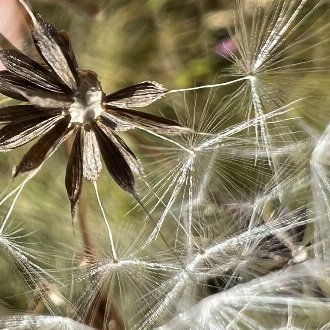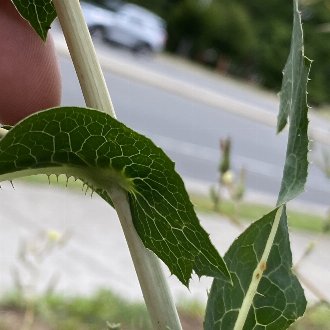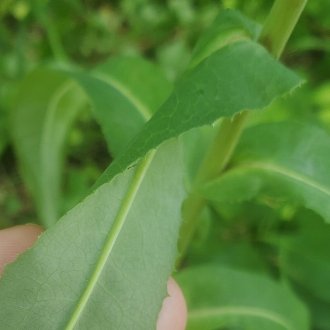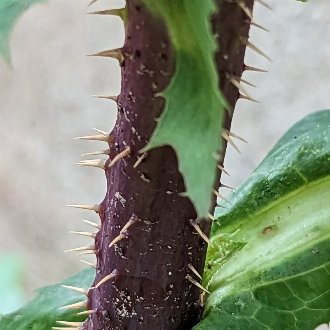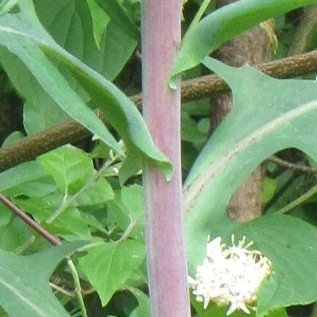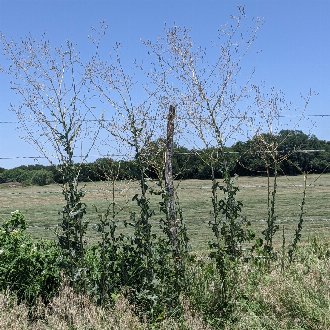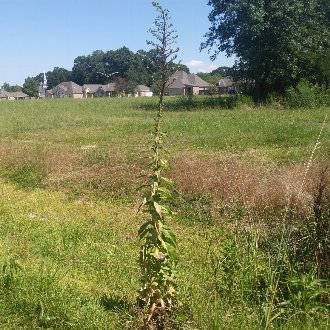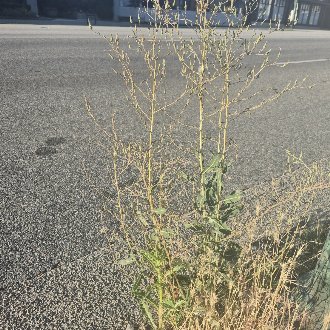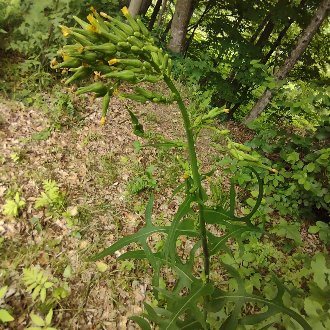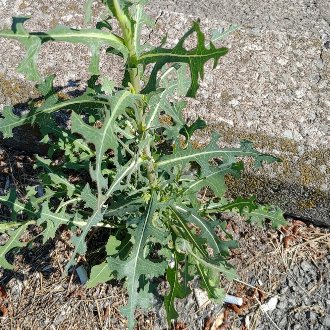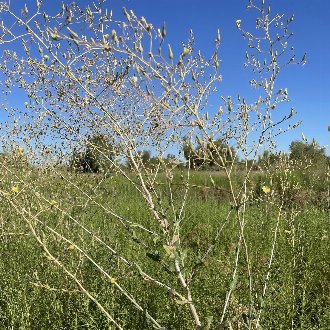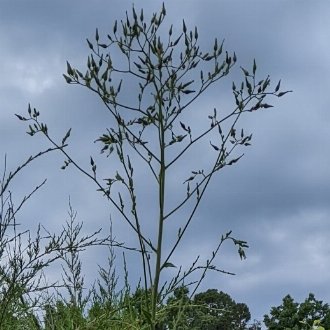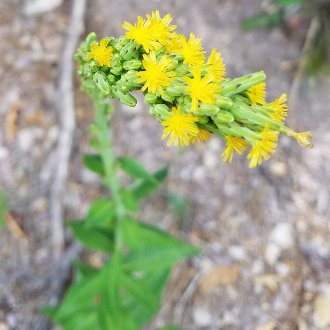Prickly Lettuce vs American Wild Lettuce
These two lettuces, one native and one introduced and invasive, are sometimes confused. Although they are usually easy to distinguish, it can be hard to learn how to do so because of high variability within each species. Close examination of the seeds, or presence/absence of prickles are most reliable for ID, whereas the other traits are largely-overlapping. L. serriola ranges farther west and favors drier, sunnier, more barren habitats, in the east strongly favoring anthropogenic habitats, whereas L. canadensis ranges farther north and south in the east, tolerates more shade, and prefers moister, richer soil and more competing vegetation.
Prickly Lettuce (Lactuca serriola) | American Wild Lettuce (Lactuca canadensis) |
An annual native to Europe, Asia, and North Africa, introduced to North America where it is often considered invasive. | A tall biennial native to eastern North America, having expanded its range westward as well. |
Seeds average shorter (2.5–3.5 mm) and narrower, usually have 5-9 veins along their length, rarely as few as 3. Beaks (stem connecting the seed to the pappus or wispy part) average longer, 2.5-4mm, and are often longer than the seed. Photo © Steve Matson, CC BY 4.0. | Seeds are much longer (5-6mm) and wider, and usually have 1 central vein, rarely up to 3. Beaks average shorter, 1-3 mm, and are consistently much shorter than the seed. Photo © Jennifer Aitkens, CC BY 4.0. |
Leaf margins are usually (not always) prickly, midribs underneath leaves are usually prickly, only rarely smooth. Leaves tend to feel tougher and more leathery. Photo © Lexi Amico, CC BY 4.0. | Leaf margins may have teeth, but never prickles. Midribs underneath leaves are usually smooth, occasionally have long, moderately stiff hairs, but hairs are not prickly. Leaves tend to feel thinner and more delicate. Photo © Alex Zorach, CC BY 4.0. |
Stems are sometimes (not always) prickly. Photo © Nikokin, CC BY 4.0. | Stems are never prickly. Photo © Ken Kneidel, Public Domain. |
Plants average much shorter, commonly 30-70cm (1-2.3 feet), rarely to 100cm / 3.25 feet or higher. Photo © Austin R. Kelly, CC BY 4.0. | Plants average much taller, commonly 40–200cm (1.3-6.5 feet), occasionally to 450cm (14.75 ft) or even higher. Photo © Mike Tilley, CC BY 4.0. |
More restricted to sunny habitats and tolerates poorer or thinner soils. More common in anthropogenic habitats such as roadsides, railroads, vacant lots, industrial waste ground, or other paved areas. Photo © Syd Cannings, CC BY 4.0. | More tolerant of shade, but requires richer soils. More common in natural areas, and ranges deeper into partly-wooded habitats. Photo © Cyndy Sims (Parr), CC BY 4.0. |
Plants are usually annuals, uncommonly biennials, and usually only form rosettes for a brief period shortly after germination. Mid-growing-season, nearly all plants will be growing upright, preparing to flower later in the season. Photo taken during June in Ontario. Photo © S Brian Treelife, Public Domain. | Plants are usually biennials, and it is common to find rosettes of plants growing mid-growing-season, with no flowering stem. These plants will not flower until the next growing season. Photo taken during June in Ontario. Photo © Patrick Jackson, CC BY 4.0. |
Mature inflorescences tend to have a more panicle-like structure, with many branches and flowerheads at many different heights, flowerheads not as concentrated at the top. Photo © Amelia Tauber, CC BY 4.0. | Mature inflorescences may be panicle-like but on average tend more towards a corymb-like structure, with flowerheads more concentrated near the top. Some inflorescences are much narrower. Photo © Alison Northup, CC BY 4.0. |
Flowers a few weeks later on average. On larger plants, inflorescence usually has at least some fully-developed branches by the time plants begin blooming, and buds are more spaced out along the stem when the first blooms open. Photo from August 5th in Washington, DC. Photo © Frederick Nunley, CC BY 4.0. | Flowers a few weeks earlier on average. Flowerheads begin to open before inflorescence is fully developed or unfurled, leading the first blooms to appear in a dense cluster of unopened buds. Photo from July 11th in Bristol, TN. Photo © Bob Schwartz, CC BY 4.0. |
Lobe tips tend to curve back towards the base of each leaf. Lobe tips are more likely to fork or branch slightly. Photo © Nico Carl, CC BY 4.0. | Lobe tips tend to point straighter outward, perpendicular to the leaf's midrib, not curving back as much. Lobe tips usually do not fork or branch as much. Photo © Bryan Connolly, CC BY 4.0. |
Flowerheads usually have 12-20 rays and may even occasionally have fewer than 12. Rays tend to overlap less and be easier to count in photos. Photo © Engers, CC BY 4.0. | Flowerheads usually have 15-20 rays, occasionally more than 20. Rays tend to overlap more and be harder to count in photos. Photo © Daniel J. Layton, CC BY 4.0. |
Flowers are usually a paler yellow color. However, color is variable with much overlap: some plants can have richer yellow or even reddish flowers. Photo © Aaron Liston, CC BY 4.0. | Flowers are usually a more saturated, slightly more orangeish hue of yellow, and reddish-tinged flowers are more common. However, color is variable with almost complete overlap: some plants can have paler yellow flowers, even bluish. Photo © Laura Costello, CC BY 4.0. |
Additional Notes
The greater height of L. canadensis reflects its adaptation to richer habitats and greater competition, contrasting with the lesser height of L. serriola corresponding to its adaptation to more barren habitats with less competition. The larger seeds of L. canadensis also help it to establish in habitats with steeper ground-level competition. The biennial habit of L. canadensis in which a rosette is followed by a tall plant corresponds to the typical vegetation structure in rich habitats following a disturbance: the rosette establishes shortly after a disturbance that removes competing vegetation, but in the subsequent year, a tall stem is necessary to push up through other vegetation. L. serriola often colonizes habitats that are disturbed more frequently, thus benefiting from an annual lifecycle.The prickles and tougher foliage of L. serriola likely reflects an adaptation to greater herbivory, which is related to how it often stands alone in habitats with little other vegetation. The more tender foliage and lack of prickles may reflect decreased herbivory pressure as L. canadensis is more likely to be surrounded by other vegetation.
FSUS references stem color in their key as a way to distinguish these species; we found this unreliable as we have seen examples of L. serriola with reddish to purplish stems, which in the key would point towards L. canadensis and other species. On plants without reddish or purplish stems, the stem color may be at least somewhat reliable, with L. serriola having a strong tendency towards whitish to pale green stems, and L. canadensis averaging a darker green color (but still paler than many plants.)
The National Wetland Plant List (via USDA PLANTS) reports L. serriola as FAC (facultative upland vs. wetland species with no preference towards either) in the Atlantic and Gulf Coastal Plain, Eastern Mountains and Piedmont, and Great Plains, contrast to reporting L. canadensis as FACU (facultative upland, i.e. tending more towards upland sites) in these regions. Normally this would mean that L. serriola prefers moister conditions, but we found the opposite to be true, that it is the more drought-tolerant of the two species, demands higher light conditions, and prefers drier conditions. Numerous regional sources validate this observation: Illinois Wildflowers notes L. serriola preferring mesic to dry conditions whereas L. canadensis prefers moist to slightly dry conditions, and Minnesota Wildflowers says L. canadensis occurs on wetland edges and on "moist soil" but does not list these or similar conditions in the habitat for L. serriola.
We also note that FSUS' reported heliophily for the two species are 9 for L. serriola and 8 for L. canadensis. Normally this would only mean a slight difference in sunlight preference, but we have found the differences in light preference between these species to be fairly dramatic. Although there is some overlap, there is less overlap than typical for species only 1 apart on that scale.
References & External Resources
These short lists show only links helpful for ID. For a complete list of references and resources also covering other aspects of ecology, visit the links section of the full article on each plant, which is the first entry here.



